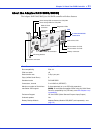
Chapter 3: About Your RAID Controller ● 18
Standard RAID Controller Features
● Support for SAS disk drives, SATA/SATA II disk drives, and SATA and SAS Solid State
Drives (SSDs)
● Flash ROM for updates to controller firmware, BIOS, and the Adaptec RAID
Configuration utility
● Disk drive hot-swapping
● Event logging and broadcasting including email and SNMP messages
● Multiple options for creating and managing RAID arrays—A full software application
(Adaptec Storage Manager), a BIOS-based utility (ACU), a command line utility
(ARCCONF) (see Managing Your Storage Space on page 79)
● Native command queuing (NCQ), which lets disk drives arrange commands into the most
efficient order for optimum performance
● Support for disk drive enclosures with SES2 enclosure management hardware
● Support for a battery backup module (see page 19)
● Support for a zero maintenance cache protection module (see page 19)
● Support for Adaptec maxCache
TM
SSD caching (see page 109)
Note:
Adaptec maxCache is supported on Adaptec Series Q controllers only.
● Power-management of disk drives in your storage space to reduce cooling and electricity
costs (see page 106)
● Audible alarm
● I/O statistics logging
Array-level Features
Note:
Not all features are supported by all controllers. For more information, refer to the
Adaptec
Storage Manager User’s Guide
or online Help.
● Support for RAID 0, RAID 1, RAID 5, RAID 10, RAID 50, simple volumes, and spanned
volumes
● Support for hybrid RAID 1 and RAID 10 arrays comprised of hard drives and Solid State
Drives (SSDs)
● Support for JBOD disks (appear as a physical disk drives to the operating system; not
redundant)
● Support for hot spares (global and dedicated)
●
Support for automatic failover, so arrays are automatically rebuilt when a failed drive is
replaced (applies to redundant arrays in SES2- or SAF-TE-enabled disk drive enclosures
only
)
● Optimized disk utilization, which ensures that the full capacity of all disk drives can be
used, even if the disk drives vary in size
●
Online capacity expansion, so you can increase the capacity of an array without recreating it
● Support for array migration from one RAID level to another


















